 FY22Q1 | January 2022, Issue #31
|

In Dec. 2021, FEMA Administrator Deanne Criswell released the agency’s “2022-2026 FEMA Strategic Plan,” which outlines a bold vision and three ambitious goals designed to address key challenges the agency faces during a pivotal moment in the field of emergency management. The goals are to instill equity as a foundation of emergency management, lead the whole of community in climate resilience, and promote and sustain a ready FEMA and prepared nation. These goals position FEMA to address the increasing range and complexity of disasters, support the diversity of communities we serve, and complement the nation’s growing expectations of the emergency management community.
The plan was developed with input from more than 1,000 FEMA employees and over 400 external partners, including 50 tribal nations, who provided their perspectives to help shape FEMA and guide engagements with our partners as we drive towards a more equitable, resilient, and sustainable future for our workforce and nation. The Strategic Plan puts people first — both those who work at the agency and those we serve – to ensure the agency is meeting the needs of communities and our nation.
Below is additional information on the plan’s three overarching goals that the agency will pursue over the next few years:
|
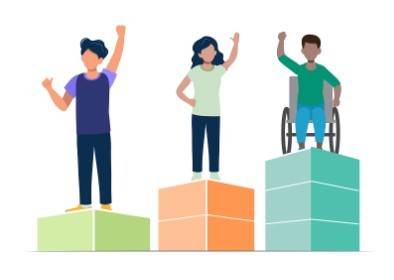
Goal 1: Instill Equity as a Foundation of Emergency Management
The importance of equity in emergency management is not a new concept. We know that historically underserved communities experience differences in preparedness and mitigation measures as well as how quickly their communities can resume social and economic life after a disaster. Moving forward, FEMA will integrate equity as a foundation of our culture through transformational change within our workforce, across our policies and programs, and throughout the emergency management community. The agency will direct resources, ensure informed decision making, and routinely evaluate our program and policies to help eliminate disparities in access and outcomes.
|

Goal 2: Lead Whole of Community in Climate Resilience
Climate change represents a profound crisis for our nation. It is causing more frequent, more intense, and more destructive natural disasters. We realize that when communities and individuals are climate literate, they are better positioned to take the necessary steps to apply that knowledge and build more resilient communities. FEMA will lead the way towards increasing climate literacy within the emergency management community helping to build a foundational understanding of climate science and the impacts of climate change. FEMA is also committed to increasing climate investments across the nation to ensure we are leveraging our grant programs to target investments enabling communities to directly address their own threats from climate change.
|

Goal 3: Promote and Sustain a Ready FEMA and Prepared Nation
As disasters have become more frequent, severe and complex, the demands placed on emergency managers continue to increase. FEMA will lead the effort to advance the emergency management profession by supporting curriculum for comprehensive training, education and professional development, accessible to our whole community partners. This ensures we are transforming our training programs to a community-based approach and making that training available to students wherever they are in the nation.
|
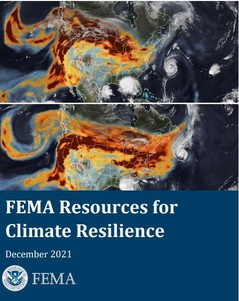
The FEMA Resources for Climate Resilience assists FEMA’s state, local, tribal, and territorial (SLTT) partners in navigating the FEMA resources that are available to support communities in adapting to the impacts of climate change and build resilience.
These resources will support communities in building resilience and adapting to the impacts of climate change and funding for community adaptation strategies. The document outlines relevant FEMA resources, including those that can help communities:
- Identify and assess climate change risk.
- Consider climate change during hazard mitigation planning.
- Fund mitigation and climate adaptation strategies.
- Build community capacity to address climate risks.
The document also includes information on how to fund mitigation and climate adaptation strategies, how a community can build capacity to address climate change and how emergency managers and officials can include climate change in their hazard mitigation planning. Stakeholders will also be able to use the quick glance overview of all FEMA funding sources to help their planning efforts.
|
In collaboration with its federal interagency partners, FEMA developed the Recovery and Resilience Resource Library to navigate the numerous programs available to the United States and its territories to help recover from a disaster. This repository of resources, which pulls resources from numerous federal agencies, is dedicated to helping users research and identify federal resources that can aid in pre-disaster recovery planning and post-disaster recovery support in the wake of a disaster or emergency. Increasing access to federal resources empowers state, territorial, tribal, and local (SLTT) governments, as well as nonprofits, businesses, healthcare institutions, schools, individuals and households. If you have any questions about the tool, please contact FEMA-ICD-OAT@fema.dhs.gov.
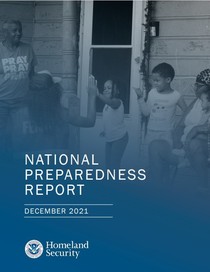
FEMA released the 10th annual 2021 National Preparedness Report (NPR). This year's report presents preparedness data through the lens of risks and capabilities and underscores the challenges that emergency managers face in addressing a continuously expanding risk environment, the ingenuity they have shown to rise to those challenges, and opportunities that remain to better prepare the nation. Emergency managers and whole community partners across the nation can look to this year's report to help support decisions about program priorities, resource allocations, and community actions.
The report summarizes the state of national preparedness, discussing the risks the nation faces and how those risks drive whole-community emergency management capability requirements. The report includes the following findings and discussion topics:
- Climate change continues to impact the nation and worsen existing vulnerabilities, many of which were revealed by the COVID-19 pandemic. For example, ongoing racial, social, and financial inequalities may limit response and recovery during and after disasters.
- Vulnerabilities remain within supply chains and aging infrastructure. The risks posed by misinformation and cyber threats continue to increase in scale and impact faster than the nation is able to build the capabilities needed to manage them.
- Overall, the nation is closer to achieving its preparedness goals identified through the National Threat and Hazard Identification and Risk Assessment; however, affected communities may not be fully prepared to respond to nationally catastrophic incidents.
- The COVID-19 pandemic shows that many gaps remain in the nation's preparedness; however, this provides an opportunity to identify strengths and shortfalls in capabilities, and apply lessons learned in a strategic way.
For the first time ever, the report provides management opportunities outlining steps that community leaders can take to address capability gaps. These include a justification for a preparedness investment strategy to help close capability gaps and improve capabilities, an explanation of what all levels of government are doing or can do to manage climate change, and how climate change worsens existing vulnerabilities.
It also includes a discussion of the National Preparedness System and the importance of maintaining the connections between the components of this system, including the Threat and Hazard Identification and Risk Assessment and Stakeholder Preparedness Review, threat and hazard modeling, and planning.
|
FEMA has announced that the National Board for the Emergency Food and Shelter Program (EFSP) allocated $530 million to jurisdictions (counties and cities) across the country to assist our nation’s hungry and homeless populations.
The program’s National Board will distribute the funds to local organizations dedicated to feeding, sheltering and providing critical resources to people with economic emergencies. These funds are for people with non-disaster related emergencies and can be used for a broad range of services, including mass shelter, mass feeding, food pantries and food banks, utility bill payments to prevent cut-offs, rent/mortgage payments to prevent evictions/foreclosures and transition assistance from shelters to stable living conditions.
EFSP funding is allocated to qualifying local jurisdictions based on a formula using the most recent national population, unemployment, and poverty data. Grants are then awarded by local boards to nonprofit and government organizations that provide direct services to those in need in their communities. All applications are evaluated competitively.
Find information about allocations on the EFSP website. Learn more about how EFSP funds help Americans rebuild their lives. A state-by-state list of the eligible jurisdictions and award amounts is available at www.efsp.unitedway.org.
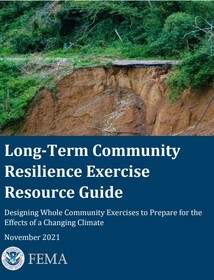
In Nov. 2021, FEMA released updates to the Long-Term Community Resilience Exercise Resource Guide, a "one-stop-shop" for any jurisdiction or organization interested in using a climate-focused exercise to better understand their long-term risk and evaluate actions to mitigate them.
Exercises provide an effective forum for the public to develop a common understanding of risk, assess current capabilities, and identify preparedness gaps and other needs to be addressed through future planning. The guide is helpful for planning and conducting scenario-based exercises. It uses different time horizons and levels of climate risk to help visualize the future and evaluate options for constructive action to adapt to climate changes already occurring and those to come. This guide equips users with:
- A dictionary with common terms to ensure a shared understanding of climate-related terminology and principles before an exercise.
- Tools and templates for planning and conducting climate-focused exercises.
- Resources including funding opportunities, risk assessments and training programs.
The guide offers the latest Homeland Security Exercise and Evaluation Program (HSEEP) guiding principles, new discussion prompts specific to climate change and social justice, and noteworthy resources from across the interagency.
|
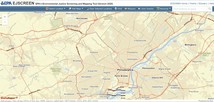
EPA is holding the next set of ‘Office Hours’ for users of EJSCREEN, the Agency's environmental justice screening and mapping tool. These Office Hours are a chance for the public to talk with EPA EJSCREEN experts about many topics including how to use and apply the tool, technical issues, and any other questions. EPA will hold these sessions on a bimonthly basis. This session is scheduled for Feb. 23, 2022 at 12:00 p.m. EST. The office hours will be accessible via Zoom and registration is not required.
Meeting Link: Feb. 23, 2022 at 12:00 p.m. EST
During these bimonthly conversations, EPA will give brief updates on new features in EJSCREEN, upcoming changes, or other relevant topics. However, the majority of the time will be reserved for stakeholder questions and feedback. There will not be an agenda or formal presentations.
Join these open discussions and learn about EJSCREEN, as well as to get your questions answered. For more information on the EJSCREEN Office Hours and to access recordings of past sessions, please visit: https://www.epa.gov/ejscreen/ejscreen-office-hours. For more information on EJSCREEN, please visit: https://www.epa.gov/ejscreen.
|

In Oct. 2021, the Virginia Department of Emergency Management (VDEM) officially announced the opening of the new Office of Diversity, Equity, and Inclusion (ODEI) located in Chesterfield, Virginia at VDEM Headquarters. The official opening of this office establishes Virginia as the first state in the nation to create an Office of Diversity, Equity, and Inclusion within a state emergency management office. The ODEI will provide subject matter expertise, strategic leadership, and technical assistance to VDEM staff, partners, and key stakeholders on best practices for ensuring emergency management plans are equitable and prioritize vulnerable and at-risk populations before, during, and after disasters.
Embedding diversity, equity, and inclusion into emergency management and the agency’s overall daily operations have been critical, especially since the beginning of the COVID-19 response. COVID-19 continues to highlight the inherent disparities that exist within our society and key vulnerabilities that are often worsened during emergencies and disasters. In the past decade, there has been an increase in the frequency and severity of disasters across the nation and Virginia. This office will be key to ensuring vulnerable communities who are historically disproportionately impacted by disasters receive much proportional resources and support.
After a national search, VDEM selected Sable K Dyer to serve as the inaugural Director of the Office of Diversity, Equity, and Inclusion. Prior to joining the VDEM team, Dyer served as the Acting Director of the Office of Health Equity, Division Director for Multicultural Health & Community Engagement, Chair of the Health Equity Working Group, and member of the Health Equity Leadership Task Force.
|
Launched by President Biden in Jan. 2022, the National Building Performance Standards (BPS) Coalition comprises a nationwide group of state and local governments that have committed to inclusively design and implement building performance policies and programs in their jurisdictions. The National BPS Coalition is a first-of-its-kind partnership between 33 state and local governments dedicated to delivering cleaner, healthier, and more affordable buildings. With nearly 20 percent of the nation’s building footprint in their jurisdictions, the partnership facilitates new commitments to design and implement building performance standards at the state and local level, create good-paying, union jobs, lower energy bills for consumers, keep residents and workers safe from harmful pollution, and cut emissions from the building sector.
A National BPS Coalition is an opportunity to heighten the country's ambition. By harnessing the momentum of recent movers and leveraging past work across the country to normalize disclosure practices, National BPS Coalition can launch wider BPS processes from stronger footing. Next-wave BPS can align emissions, electrification, and equity goals with retrofit requirements. But they won’t meet equity objectives without sustained and empowered voices from disadvantaged communities. By centering equity, the National BPS Coalition can catapult the climate-smart buildings movement to new heights.
In support of participating jurisdictions, federal agencies including the US Department of Energy and the Environmental Protection Agency are providing technical assistance. The Department of Energy also offers several funding programs for state and local governments to support their policy implementation and building retrofit activities. Federal support to Coalition members is complemented by non-governmental and labor organizations offering resources for workforce engagement, equity strategies, localized policy design, and stakeholder engagement.
Click here for the White House Fact Sheet about the launch of the National BPS Coalition. To learn more about the National BPS Coalition, click here for the website.
In Jan. 2022, the US Small Business Administration (SBA) and Business Forward, Inc., a non-profit organization working with small business leaders in support of policies promoting America’s economic competitiveness, announced the launch of the Small Business Digital Alliance (SBDA). A joint public-private co-sponsorship, the SBDA will connect small businesses with critical tech resources to start and expand their e-commerce business to scale for success. The new initiative will also feature a series of free briefings and training to help small businesses access and utilize these digital tools to reach new markets, find diverse talent, improve operations, and raise capital.
Beyond access to technical skills development and tools, the SBDA will play a significant role in helping entrepreneurs expand their networks -- a key component for small businesses as they seek new customers and stronger relationships with vendors, lenders, and other stakeholders needed for success. Specifically, through the SBDA, the SBA and Business Forward will convene some of America’s most respected leaders in business, government, economic development, and other aligned spaces to facilitate cooperation and help small business owners fully harness the power of technology to fuel growth.
Small businesses depend on a comprehensive suite of tools to expand their customer base, manage their growth, find and retain talent, and enter new markets, including globally, but often encounter obstacles. Aligned with the Biden-Harris Administration’s focus on equity and leveling the playing field, the collaboration with Business Forward through the SBDA will prioritize creating access to competitive opportunities and lowering barriers to entry for small businesses, especially those from historically underserved and disadvantaged communities across the country.

As the United States continues to navigate the many economic challenges posed by the COVID-19 pandemic, a new data tool helps provide communities a clear, detailed understanding of the pandemic’s impacts on local economies — and whether those communities might qualify for economic help.
Developed through a partnership between the US Department of Commerce’s Economic Development Administration (EDA) and the US Department of Energy’s Argonne National Laboratory, the National Economic Resilience Data Explorer (NERDE) provides a single, easy-to-use platform to access data on economic distress, employment and gross domestic product, clusters of industries and ongoing COVID-19 impacts for all Economic Development Districts (EDDs), as well as the more than 3,000 counties across the nation.
Community leaders can use the new tool to determine possible eligibility for EDA assistance as part of the American Rescue Plan, the $1.9 trillion stimulus effort to accelerate ongoing recovery from the pandemic and enhance local economic resilience to future shocks. The tool can also help to inform local and regional economic development plans and initiatives.
The dashboard’s main page tracks near real-time impacts to local economies during the COVID-19 pandemic and provides insight into the recovery over time. Is the EDD’s or county’s economy worse off now, in the same shape, or in better condition than before the pandemic? One look at the dashboard’s County Economic Impact Index gives the answer. The tool provides an important regional perspective on economic health and vitality, allowing community leaders to design and implement projects more strategically.
The dashboard, available on Argonne’s website, also lets decision makers delve into the following:
- Unemployment rate and its change within the top five industries in the EDD or county, ranked by Gross Domestic Product (GDP).
- Per-capita income.
- Top industries by employment and GDP and their growth rates.
- Concentration of local and regional industries.
- Economic risk factors or indicators of special need such as persistent poverty, lack of innovation, high concentration of coal sector jobs or proximity to federally recognized tribal lands.
- Economic changes over time, monthly throughout the COVID-19 pandemic.
|
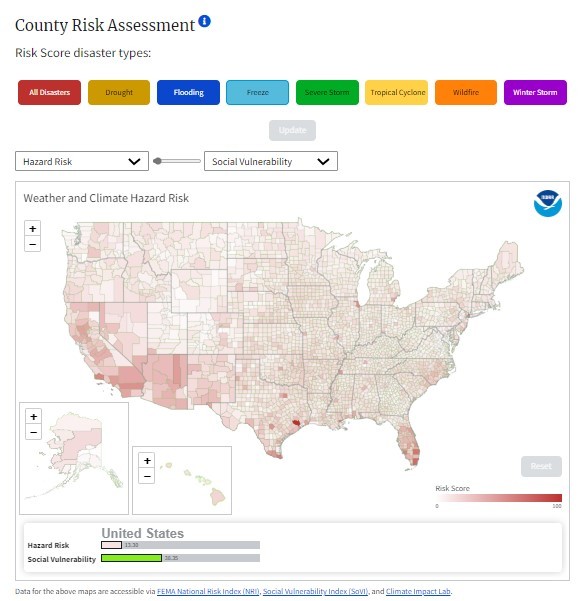
NOAA’s National Centers for Environmental Information (NCEI) has released an innovative mapping tool that provides county-level information on natural disaster hazards across the United States. This new feature provides significant enhancements to the state-level data on NOAA’s Billion-Dollar Disasters website.
Developed by NCEI with data from NOAA, FEMA, and academic institutions, this interactive NOAA mapping tool provides detailed information on a location’s susceptibility to weather and climate hazards that can lead to billion-dollar disasters—such as wildfires, floods, drought and heat waves, tornado outbreaks, and hurricanes. The tool expands upon FEMA’s National Risk Index to provide a view of a location’s risk for, and vulnerability to, single or multiple combinations of weather and climate hazards for every county and county-equivalent in all 50 states, and the District of Columbia.
NOAA will continue developing tools like this in order to deliver authoritative climate and data services to the public. Watch this demonstration to learn how to navigate this new tool.
|
The US Department of Agriculture (USDA) is making up to $10 million available to help people living in rural towns develop community renewable energy projects that will help them cut their energy costs and contribute to the nationwide effort to reduce pollution that contributes to climate change. These funds will be targeted to help people who live in communities that have been historically underinvested and disinvested.
USDA is making the funds available through the new Rural Energy Pilot Program (REPP) to help the people of rural America build back better, stronger and more equitably than ever before. Through this program, USDA is supporting the Biden-Harris Administration’s commitment to making environmental justice a part of every agency’s mission to address the disproportionate health, environmental, economic and climate impacts on disadvantaged communities.
The funds can be used to deploy community-scale renewable energy technologies and innovations to reduce climate pollution and increase resilience to the impacts of climate change. These technologies include solar, wind, geothermal, micro-hydroelectric and biomass/bioenergy. Up to 20 percent of awarded funds may also be used for community energy planning, capacity building, technical assistance, energy efficiency and weatherization.
USDA is offering priority points to projects that advance key priorities under the Biden-Harris Administration to help communities recover from the COVID-19 pandemic, advance equity and combat climate change. These extra points will increase the likelihood of funding for projects seeking to address these critical challenges in rural America.
Prospective applicants must inform the Agency by submitting a required Letter of Intent prior to submission of a complete application. The letters must be submitted via electronic upload into a secure cloud vault, by 11:59 p.m. EST on Apr. 19, 2022.
Application guides and submission information are available on the program website, under the "To Apply" tab, www.rd.usda.gov/programs-services/energy-programs/rural-energy-pilot-program.
For additional information, see page 2747 of the Jan. 19 Federal Register (PDF, 278 KB).
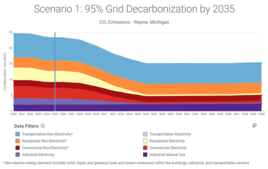
The State and Local Planning for Energy (SLOPE) Platform's new, ground-breaking Scenario Planner tool visualizes scenarios for future energy consumption, CO2 emissions, and system costs of a selected state or county. Users can select and explore various energy planning pathways, including grid decarbonization and electrification strategies, in isolation and in combination to showcase how different scenarios compare and interact. The SLOPE Platform integrates and delivers data on energy efficiency, renewable energy, and sustainable transportation into an easy-to-access online platform to enable data-driven state and local energy planning.
Learn more about the Scenario Planner Tool and see a live demonstration of its functionality and potential applications in an upcoming webinar. Register for the launch webinar on Feb. 15, 2022 from 2-3 p.m.
|
The US Army announced on Jan. 19, 2022, the Civil Works studies, projects and programs that the Corps would implement in Fiscal Year 2022 with the $22.81 billion in supplemental funding provided in two recently enacted laws — the Infrastructure Investment and Jobs Act; and the 2022 Disaster Relief Supplemental Appropriations Act.
The spend plan supports the Administration hitting the ground running by focusing on current Fiscal Year 2022 spending. Future announcements will provide spend plans for subsequent years. Each spend plan will be in continued support of Administration goals of expanded access to America’s ports through dredging, as well as building resilience in the face of global climate change, while benefitting economically disadvantaged communities and regions, and advancing environmental justice.
Bipartisan Infrastructure Deal: Infrastructure Investment and Jobs Act, Public Law 117-58
With the $17.099 billion provided in Public Law 117-58, the Army will fund Army Civil Works studies and projects, maintain existing infrastructure, and repair damage and dredge channels in response to floods and coastal storms. Through this investment in water resources infrastructure, over $5 billion will help improve community resilience in the face of global climate change and $3.936 billion will address commercial navigation improvements at coastal ports and on the inland waterways. In the coming year, the Army will engage with environmental justice communities in the development of a strategy to allocate $130 million in two pilot programs authorized in the Water Resources Development Act of 2020 that target economically disadvantaged community’s needs. As part of this effort, the Army plan funds to completion 15 feasibility studies, the Preconstruction Engineering and Design (PED) phase of 5 projects, and 19 construction projects in Fiscal Year (FY) 2022. Additionally, in FY 2022, 22 new projects will be funded in the Construction account.
Disaster Relief Supplemental Appropriations Act, 2022, which is Division B of Extending Government Funding and Delivering Emergency Assistance Act, 2022, Public Law 117-43
Of the $5.711 billion supplemental funds that Public Law 117-43 provides for the Army Civil Works Program, $100 million is designated for studies of proposed projects in the four states where major disasters were declared in FY 2021 due to Hurricane Ida – Louisiana, New Jersey, New York, and Pennsylvania. Leveraging these funds, 11 feasibility studies, plus the preconstruction engineering and design for six projects, will be funded to completion within the Investigations account in FY 2022.
This law also provides $3 billion for construction of qualifying flood and storm damage reduction, including shore protection, projects, with $1.5 billion to be put toward projects in the four states where major disasters were declared in FY 2021 due to Hurricane Ida. The Army will use this funding, in part, to construct a total of 11 projects in FY 2022, including 5 in states where major disasters were declared due to Hurricane Ida, and 6 in other states and territories.
Additional details regarding the amounts provided to various programs, projects and activities for each of the five appropriations accounts for FY 2022 may be found at: https://www.usace.army.mil/Missions/Civil-Works/Budget/.

NTIA recently released the first ACCESS BROADBAND Report, which highlights the accomplishments of NTIA’s recently established Office of Internet Connectivity and Growth (OICG) over the past year. The report, mandated by the ACCESS BROADBAND Act as part of the Consolidated Appropriation Act of 2021, also covers investments in federal broadband support programs and Universal Service Fund (USF) programs.
The ACCESS BROADBAND Report is part of NTIA’s continued effort to improve availability of broadband-related data, enhance coordination across federal partners, and enable transparency in government spending. It was developed in coordination with 13 federal agencies comprising 55 total programs.
The report summarizes the federal broadband investment landscape, outlines the current state of measuring investments and connection across federal broadband support and USF programs, and provides key recommendations to improve efforts to track broadband spending and outcomes. These recommendations include: promoting consistency across programs; leveraging open data initiatives; and identifying data sources and alternatives.
|
On Jan. 18, 2022, the US Department of Health and Human Services (HHS), through the Health Resources and Services Administration (HRSA), announced the availability of $13 million in funding to increase access to behavioral health care services and address health inequities in rural America, including through evidence-based, trauma-informed treatment for substance use disorder.
HRSA’s Federal Office of Rural Health Policy will make awards through the Rural Communities Opioid Response Program (RCORP) - Behavioral Health Care Support. Eligible applicants include entities such as Rural Health Clinics, federally recognized tribes, tribal organizations, and community- and faith-based organizations.
Since 2018, the Rural Communities Opioid Response Program – a multi-year initiative administered by HRSA – has provided over $400 million in direct grants and technical assistance to rural communities addressing behavioral health care challenges, including substance use disorder. To date, the initiative has expanded access to substance use disorder prevention, treatment, and recovery services in over 1,500 counties nationwide, with RCORP grant recipients serving over 2 million individuals in rural communities in FY 2020.
Applicants can begin the RCORP-Behavioral Health Care Support application process on Grants.gov and must apply by Tues., Apr. 19, 2022 at 11:59 PM, ET. Visit the Notice of Funding Opportunity for more information.
|
|
by Wynne Kwan, Community Planning & Capacity Building Coordinator, FEMA Region 3
Greetings Recovery partners!
Happy New Year! Hope everyone had a wonderful holiday season. After a busy quarter at the end of the year, it is looking to be a busy year with so much going on in the recovery sphere. This edition of the Forward Recovery newsletter reflects this activity; it is jampacked with lots of information about new programs, resources, tools, and funding opportunities to kick off the new year.
Back in Dec. 2021, FEMA released its 2022-2026 Strategic Plan, emphasizing equity, climate resilience, and readiness. I had the honor of participating in one of the Strategic Plan Objective Working Groups, focusing on "Objective 3.3: Unify coordination and delivery of federal assistance." This particular objective reinforces the work we already do in the Interagency Recovery Coordination realm to align resilience, disaster, and recovery programs across the federal interagency. With this Strategic Plan mandate, we hope to reduce the burdens communities are confronted with when trying to navigate the vast range of federal programs by partnering with federal interagency partners to better sequence federal disaster recovery programs. This includes identifying and reducing potential gaps in recovery programs and better enabling individuals and communities to use federal support to drive their own recovery. I am excited about this new Strategic Plan, as it provides the foundation to further maintain and build connections and partnerships to better serve communities.
The big news in the last months of 2021 was the enactment of the Infrastructure Investment and Jobs Act (IIJA), also known as the Bipartisan Infrastructure Bill. With its passing, $1.2 trillion has been allocated for broadband access, clean water, and electric grid renewal, as well as transportation and road. To assist communities with navigating this new funding opportunity, this edition of the newsletter highlights the Infrastructure Investment & Jobs Act: A Federal Investment Guide for Local Leaders. I've compiled a few additional resources, and will add more as new information and resources become available:
As always, feel free to reach out - either directly or to the Region 3 NDRF mailbox (FEMA-R3-NDRF@fema.dhs.gov). In the meantime, stay safe and take care!
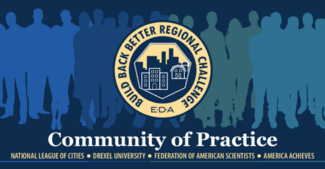
In Dec. 2021, US Secretary of Commerce Gina Raimondo announced the 60 finalists of the Economic Development Administration’s (EDA) Build Back Better Regional Challenge. The transformative, $1 billion investment in American innovation aims to develop and strengthen regional industry clusters across the country, all while embracing economic equity, creating good-paying jobs, and enhancing U.S. competitiveness globally.
Each of the finalists will have the opportunity to tap up to $100 million in federal funding during Phase 2. It’s also a chance for them to access technical assistance to build capacity and improve their Phase 2 proposals, as well as to connect, communicate and collaborate with like-minded coalitions, growing a shared body of knowledge to drive the future of American economic development.
To manifest this spirit of collaboration, EDA has launched a Build Back Better Regional Challenge Community of Practice, supported through a $3 million grant to the National League of Cities, with sub awardees America Achieves, the Federation of American Scientists and the Nowak Metro Finance Lab at Drexel University. It will run Jan.-Sept. 2022, bringing together all 60 finalists with the goal of supporting the development of strong Phase 2 applications while creating a sense of community and the sharing of best practices.
In partnership with EDA headquarters and its six regional offices, the Community of Practice will work with the finalists to translate their concept proposals into comprehensive, actionable plans that leverage regional assets, build new local partnerships and accelerate their economic vision within their Phase 2 applications. Community of Practice members will each receive a variety of individualized and group technical assistance that includes regular group-wide convenings and peer-to-peer learning opportunities with other finalists.
This coalition, consisting of the National League of Cities, America Achieves, Drexel University’s Nowak Metro Finance Lab, and the Federation of American Scientists, will bring a wealth of knowledge to the 60 finalists. Among these four partners, areas of expertise include workforce development, equitable economic growth, governance, coalition building, project formulation and planning, and technology-based economic development.
This is the first award in a planned series of grants under the American Rescue Plan Act designed to fund communities of practice. EDA anticipates awarding a second, long-term Community of Practice for Build Back Better Regional Challenge Phase 2 awardees. Details on this initiative will be announced in the near future.
For more information on the Build Back Better Regional Challenge, visit the Challenge’s dedicated section of the EDA website.
|
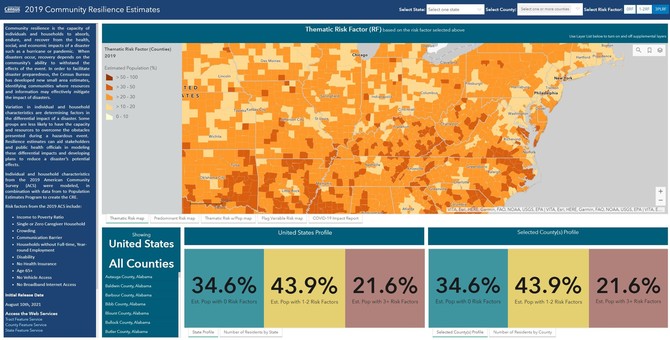 To further broaden understanding of equity in communities across the country, the US Census Bureau’s Community Resilience Estimates (CRE) program just released a new data product: CRE for Equity. The tool includes a new dashboard and data that helps users understand their communities’ social vulnerability and equity. The new dataset delivers information about residents (anyone who lives in a community) — like their internet access and health insurance coverage among others. The data provide context for the topics of social vulnerability and equity by providing data about different communities and how they compare to the national average.
What is the CRE?
The Community Resilience Estimates provide an easily understood metric for how at-risk every neighborhood in the United States is to the impacts of disasters, including wildfires, flooding, hurricanes, and pandemics such as COVID-19. Modeled estimates are based on 10 resilience-related risk factors. Current estimates are modeled using 2019 American Community Survey data and display the number and percentage of residents living with 0, 1-2, and 3 or more risk factors for the nation, states, counties, and census tracts. In addition to providing an easily understood metric of social vulnerability, the CRE program provides data users the information they need to make informed decisions. The 2019 Community Resilience Estimates Equity Supplement adds to the discussion of equity by pairing data from the 2019 Community Resilience Estimates with 2015-2019 American Community Survey. The end product is a dataset which provides the latest information on social vulnerability and equity in one source.
Furthering the Equity Conversation
The CRE program provides data that cannot be replicated with aggregated publicly-available data alone because it uses data about individuals and households from the American Community Survey (ACS) to help determine why a community is considered “at risk”. The CRE for Equity data tool guides users in the interpretation of the uncertainty ingrained in survey estimates. This is done by providing “flag variables” in the CRE for Equity that provide context and help users understand if individual statistics are higher or lower than the national average.
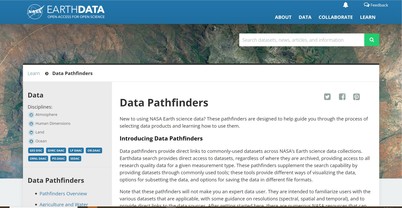
Data pathfinders provide direct links to commonly-used datasets across NASA’s Earth science data collections. Earthdata search provides direct access to datasets, regardless of where they are archived, providing access to all research quality data for a given measurement type. These pathfinders supplement the search capability by providing datasets through commonly used tools; these tools provide different ways of visualizing the data, options for subsetting the data, and options for saving the data in different file formats. Data Pathfinders are available for the following topics:
-
Agriculture and Water Resources - This pathfinder directs users to NASA datasets that can aid in forecasting future events or responding to current events, such as drought.
-
Biological Diversity and Ecological Forecasting - This pathfinder directs users to NASA datasets that can aid in monitoring changes in biodiversity, whether natural or human-induced, species distribution modeling, and conservation management.
-
Disasters - This pathfinder directs users to NASA datasets that can aid in monitoring conditions that might contribute to natural disasters, measuring and mitigating risk, and assessing post-event impacts to surrounding areas.
-
Diseases - This data pathfinder provides links to relevant datasets that can be used in each of these cases along with examples of tools that can be helpful in working with data records that help address, inform, and monitor many of the factors mentioned above, including air and water quality, habitat suitability, seasonality, and changes in Earth's environment due to changes in human behavior.
-
Geographic Information Systems (GIS) - The pathfinder directly links to geospatial web services and tools from NASA.
-
Greenhouse Gases - The pathfinder highlights data on carbon dioxide, methane, nitrous oxide, ozone, chlorofluorocarbons, and water vapor.
-
Health and Air Quality - This pathfinder provides data on air quality that can be used to visualize trends, aid in forecasting events or the movement of pollutants, and responding to events.
-
Sea Level Change - This pathfinder directs users to NASA datasets that can aid in monitoring changes in glaciers ice sheets, ocean processes, land water storage, vertical land motion, and glacial isostatic adjustment as contributors to a changing sea level. The pathfinder also provides access to datasets for monitoring the impacts of and the risk of coastal communities to sea level change.
-
Sustainable Development Goals (SDG) - This series of pathfinders provide NASA observations or high-level products that are useful to produce SDG indicators, support SDG monitoring and implementation, and evaluate progress toward achieving sustainable development.
-
Water Quality - This pathfinder highlights data that can be used to determine the impacts of changes in water quality to ecosystems, humans, and the environment and to restore and protect coastal and surface waters.
-
Wildfires - This pathfinder provides access to datasets that are critical in fire monitoring and fire management. Wildfire data, from NASA satellite missions, can be used to aid in forecasting events, monitor ongoing events, and assess post-fire areas.
|
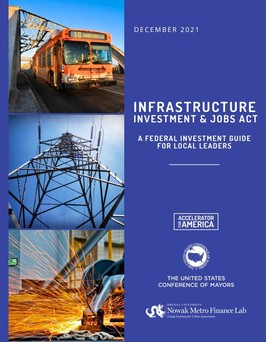
On Nov. 15, 2021, President Biden signed the historic Infrastructure Investment and Jobs Act (IIJA) into law. The IIJA supports $1.2 trillion in programming, including $550B in new spending. The act makes some of the largest investments in transportation, water, bridges, and rail in American history, and includes new investments in climate resiliency and low-emission technology to ensure we can adapt to the impacts of climate change. Despite historic federal action, the degree to which the IIJA’s potential is achieved will rest upon the actions of local leaders — and how effectively cities and communities capitalize on these funds. Local leaders must marshal funds, prioritize projects, and make clear the principles that guide their efforts. The distribution of the American Rescue Plan required local governments to organize and prepare for federal recovery dollars. Implementing the IIJA will build on these partnerships across sectors and jurisdictions to move from COVID-19 relief to an economy-wide recovery and modernization.
In collaboration with Accelerator for America, the United States Conference of Mayors, and research support from Oxford Urbanists, the Drexel University's Lindy Institute for Urban Innovation's Nowak Metro Finance Lab developed the Infrastructure Investment and Jobs Act: A Federal Investment Guide for Local Leaders to bolster the efforts of local leaders to organize public, private, and civic actors in their jurisdictions to focus on big picture investments. The guide aims to do this by identifying some of the IIJA’s most transformative programs (cumulatively more than $350B) including what they do, when cities can apply for or access the funds, and the agencies, authorities, and offices responsible for administering them. In many cases, the most important role that mayors can play is serving as a convener — bringing the right people together in a room to accomplish bigger, bolder things.
The guide is intentionally selective and not comprehensive. It focuses on 30 of the highest impact federal programs and funding streams in the IIJA that cities and local leaders should know about, representing more than $350B in spending. The guide is organized to highlight the timing, funding mechanism, and funding agency or office for programs, focusing on the following program features:
-
Is the program new or does it already exist? Existing formula programs that received supplemental funds will move the most quickly. New programs, both formula and competitive, will become available more gradually.
-
How is funding distributed? The guide focuses on formula and competitive funds so that local leaders know who will receive funds automatically and what funds will require application.
-
How big is the program and who distributes it? The guide focuses on agency and program size so local leaders know who to reach out to with questions.
-
Who receives or applies for it? The guide identifies the local parties responsible for receiving funds or applying for them. It does this to empower mayors to convene and organize the many actors involved in ensuring a range of new infrastructure programs achieve big things for their communities.
The guide is organized so that local leaders can determine how quickly individual pots of funding will flow, who will apply for or receive funding, and who to speak with for questions. IIJA funds will be most transformative when used as a supplement to strategic local and regional projects that improve equity; they will fall short of their potential when treated as many individual pots of money to be separately competed over and managed in silos. This guide was created to facilitate the big picture, transformational thinking this moment demands.
|
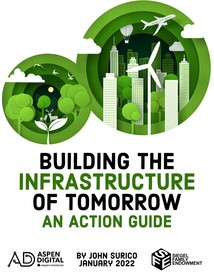
It is a new era of infrastructure investment. With last year’s bipartisan commitment of over $1 trillion in federal funds to modernize America’s bridges, airports, internet grids, and more, the US has a once-in-a-generation opportunity to reimagine and rebuild the networks that connect and sustain us. Now, as stakeholders around the country turn to the nitty gritty of allocating funds and designing plans for their communities, there are tangible actions they can take to create systems that are equitable, dynamic, and built to last.
With support from Siegel Family Endowment, Aspen Digital has developed Building the Infrastructure of Tomorrow: An Action Guide, which offers concrete ideas for how to meet this window of opportunity, which builds on existing knowledge of the multidimensional nature of infrastructure. This guide was developed in hopes that policymakers and practitioners will seize this moment to make creative, collaborative choices that meet collective infrastructure needs for years to come. This includes shifting mindsets when it comes to what qualifies for infrastructure investment, developing new metrics for success, harnessing capital in a way that maximizes both efficacy and equity, and ensuring that communities and local stakeholders are engaged throughout the process.
|

Small businesses build local wealth, with benefits for nearly every aspect of the community and region. They offer a path to prosperity for hard-working entrepreneurs. They keep a larger share of their economic output within the community than businesses with outside ownership, putting that output to work to support schools, public safety, roads, parks, affordable housing, and many other vital public needs. And young, small businesses create the bulk of the nation’s new jobs.
But one of the biggest challenges facing America’s communities is leveling the playing field for small businesses and intentionally moving away from the past decade’s Amazon-take-all trajectory. The $1.9 trillion ARPA provides America’s towns and cities with the money and encouragement to do so.
The Institute for Local Self-Reliance (ILSR) prepared a report, Small Business's Big Moment, that suggests twelve ways in which communities can use some of their ARPA allocations to strengthen and grow small businesses. The report spotlights towns and cities that are already using ARPA money to cultivate small-scale manufacturing, provide affordable commercial space, close the racial entrepreneurship gap, support employee business ownership, improve small business procurement programs, and more. Read the full report about how the American Rescue Plan Act can make this small business’s big moment.
|

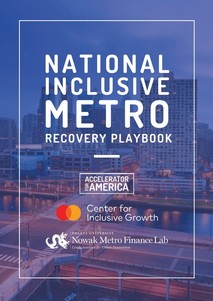
Growing minority and women-owned business is critical to accelerating the economic recovery. However, the potential to grow minority- and women-owned businesses has been vastly untapped due to long-standing wealth and opportunity gaps that have been exacerbated by the pandemic.
Developed by Accelerator for America and the Drexel University Nowak Metro Finance Lab, in collaboration with the Mastercard Center for Inclusive Growth, the Small Business Equity Tool™ (SBET) provides local leaders and economic development officials with unique insight on opportunities to grow Black-, Latino-, Asian- and Women-owned businesses in the top 100 metro regions and cities. This first-of-its-kind data tool helps leaders better understand the significant gaps that exist between Black- and white-owned businesses in their region. The Small Business Equity Tool™ (SBET) enables local leaders to benchmark and measure progress toward growing minority- and women-owned small businesses against three key dimensions: number (business density), size (average annual revenue), and sector (percentage of businesses in high-wage sectors). It further provides groups of comparison peer cities based on city demographic and economic characteristics. Along with the National Inclusive Metro Recovery Playbook, the tool enables leaders to assess the gaps in their small business ecosystem and develop actionable strategies toward achieving an inclusive recovery.
|
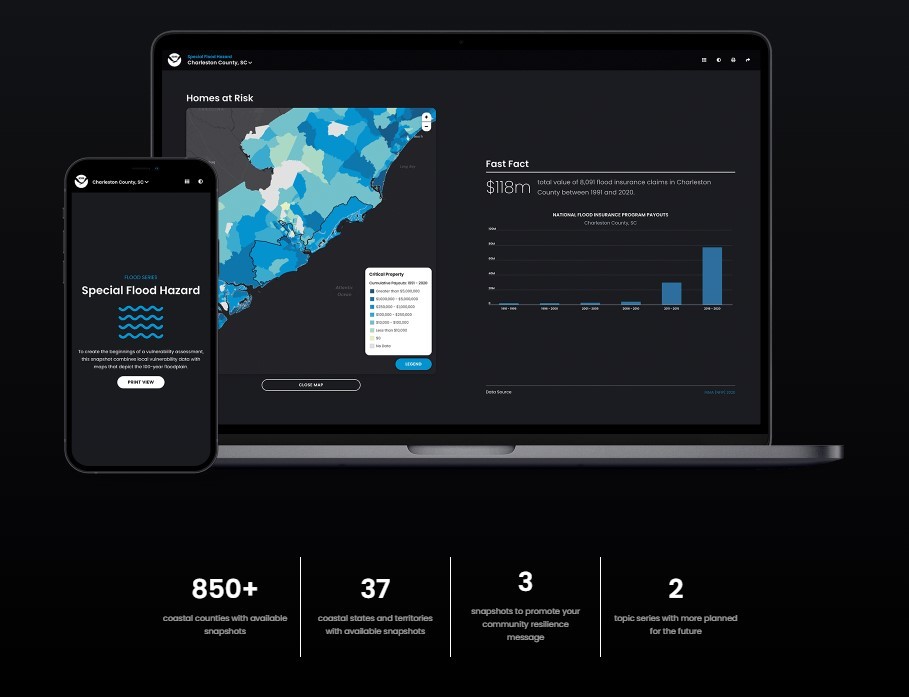 NOAA has released its new and improved Coastal County Snapshots. This Digital Coast tool provides easy-to-understand charts and graphs that describe complex, county-specific coastal data. Communities use this information to ascertain community vulnerability and to plan accordingly. Topics covered currently include coastal flooding, the coastal economy, and the marine economy. A snapshot focused on sea level rise will be added in the next couple of months.
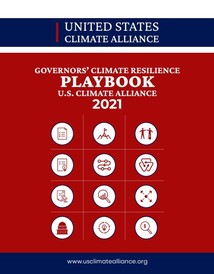
The US Climate Alliance, a bipartisan coalition of governors committed to reducing greenhouse gas emissions consistent with the goals of the Paris Agreement, developed the 2021 Governors' Climate Resilience Playbook. The 2021 Governors’ Climate Resilience Playbook outlines 12 foundational steps to set and achieve an effective state-level climate resilience agenda. This Playbook updates the 2018 U.S. Climate Alliance (USCA) New Governors’ Climate Resilience Playbook based on U.S. Climate Alliance member feedback and seeks to account for changing climate and political developments and conditions and capture some of the momentum around climate resilience action over the past few years. While the 2018 Playbook outlined what states should do to further the climate resilience agenda across states, the 2021 Playbook is focused on how to make it reality.
The buildings sector represents about 40 percent of global carbon dioxide emissions and a similar portion of U.S. emissions. This substantial impact necessitates attention and action, and it also brings with it a wide array of opportunities for decarbonization policy. In addition to the 2021 Governors' Climate Resilience Playbook, the US Climate Alliance published the 2021 Building Decarbonization Roadmap, produced in collaboration with staff from various states offices as well as industry experts. The Roadmap is not meant to represent a policy plan for the Alliance or any Alliance states, but it is rather a tool designed to summarize the highest-impact actions that states can take to decarbonize buildings.
|

The National Association of County and City Health Officials (NACCHO) and the Association of State and Territorial Health Officials (ASTHO), in collaboration with the Office of the Assistant Secretary for Preparedness and Response (ASPR) and the Administration for Community Living, developed the Capacity-Building Toolkit for Including Aging and Disability Networks in Emergency Planning (‘Capacity-Building Toolkit’).
This resource was developed to guide aging and disability networks in increasing their ability to plan for and respond to public health emergencies and disasters. This toolkit helps programs that serve people with access and functional needs, including older adults and people with disabilities, through the emergency planning process of preparedness, response, recovery, and mitigation activities. The Capacity-Building Toolkit can help organizations of all types conduct more inclusive emergency planning by facilitating personal preparedness among aging adults and people with disabilities and expanding organizational knowledge of the unique challenges facing these populations during emergencies. The Toolkit can also help emergency managers and public health officials to understand the capabilities and expertise of community-based organizations within the aging and disability network.
Organizations that are new to emergency planning can use this toolkit as an orientation to emergency planning and organizations with established emergency preparedness programs can use this as a resource to further enhance their capabilities.
|
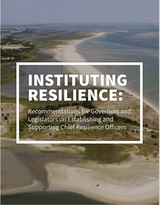
As climate impacts intensify across the country, many states and municipalities have established Chief Resilience Officers (CRO) to provide coordinated statewide leadership to reduce risks and protect communities, businesses, vital infrastructure and the environment. In Nov. 2021, the Environmental Defense Fund (EDF), Environmental Council of the States (ECOS) and National Emergency Management Association (NEMA) released a report that outlines specific recommendations for how governors and legislatures can establish and support CROs to meet the challenges of a changing climate. Instituting Resilience is the result of an EDF-led collaboration that included active CROs as well as officials from states that have been exploring creating a CRO. In addition to recommendations for establishing and supporting these positions, the roadmap outlines how the role of CRO originated and how states have established these positions over time. Access the full roadmap “Instituting Resilience: Recommendations for Governors and Legislators on Establishing and Supporting Chief Resilience Officers” here.
|
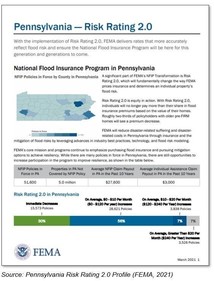
Risk Rating 2.0 State Profiles
Risk Rating 2.0 is a new pricing methodology for the National Flood Insurance Program (NFIP) that will enable FEMA to deliver flood insurance rates that are more equitable, easier to understand, and better reflect a property’s flood risk. In advance of the upcoming rating system, FEMA recently released Risk Rating 2.0 State Profiles, which provide a detailed report on how the new methodology transforms the NFIP on a state-specific level.
Each State Profile begins with an overview of the state’s NFIP and insurance landscape. NFIP participation is highlighted, with details on the NFIP policies in force and the number of properties not covered by an NFIP policy. The profile also compares the average flood insurance payments to the average Individual Assistance payments over the last 10 years.
The State Profiles can help floodplain managers explain the impacts of Risk Rating 2.0 to residents in their state. Each profile includes a chart that depicts the number and percentage of NFIP policies that will see an increase or decrease in flood insurance pricing. The chart breaks down price changes into different tiers and shows that the vast majority of premiums will be decreasing or increasing by less than $20 per month. FEMA also offers change analysis data for Risk Rating 2.0 at the county and ZIP code levels for each state.
|
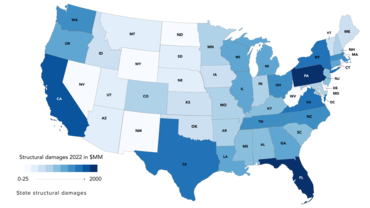
New Report Arms Commercial Property Owners With New Data to Better Prepare for Flooding
A new report from First Street Foundation and global engineering and consulting firm Arup provides new insights for communities at risk of flooding. While previous studies by First Street Foundation have provided flood risk data for individual homeowners, this report offers a data-driven assessment of flood-related risks on the commercial market. Titled “The 4th National Risk Assessment: Climbing Commercial Closures,” the report employs novel techniques to assess the risk of flood damage to 3.6 million retail, office, and multi-unit residential properties across the United States and related economic impacts, considering today’s climate and the changes anticipated to happen over the next 30 years.
The report identifies the economic impact to metropolitan areas and states from lost days of productivity and output caused by damage to retail and office buildings as well as the associated closures due to repair times. Altogether, the report provides investors, business owners, financial institutions, and economists with crucial data on the extent of flood risk to commercial and multi-unit residential properties and helps to quantify economic loss associated with that risk in ways not previously possible.
Key findings from the report include:
- A total of 729,699 retail, office, and multi-unit residential properties face risk of flood damage in the contiguous United States
- The annual costs to repair or replace damaged buildings could grow by roughly 25 percent from $13.5 billion in 2022 to over $16.9 billion by 2052 due to climate change
- Flood damage to commercial buildings could result in 3.1 million days of lost business operation in 2022 due to repairs, growing to 4 million days by 2051 – an increase of 29 percent
- Damage to commercial buildings has both revenue and downstream consequences for metropolitan areas and states. The annualized financial impact to local economies is expected to grow by 26.5 percent from $49.9 billion in 2022 to $63.1 billion in 2052
Commercial real estate supports the economic heart of American cities and multi-unit residential properties also play an important part in keeping the economy moving by housing members of America’s workforce, many of whom have had to work from home during the pandemic. As the frequency and severity of floods accelerate along with the changing climate, gaining a more comprehensive understanding of the total risk posed to these buildings and understanding the uneven effects of climate change across different metros and states is vital. This study is arming individual commercial and multi-unit residential property owners, investors, and policy makers with important data, which can be used to guide investment, adaptation measures, and policy change.
The report aggregates property-level data at the metro and state level. Additional data, including the future flood risk to individual properties, can be accessed from First Street Foundation.
|

Upcoming FEMA Region 3 Coffee Break Webinars
Federal Emergency Management Agency (FEMA) Region 3 is hosting a webinar series for hazard mitigation planners and other partners interested in reducing risk in their communities. These “Coffee Breaks” are hour-long webinar sessions hosted every other month to provide mitigation best practices and highlight the work happening at federal, regional, state, and community levels to reduce risk across the region.
Coffee Break webinars are open to everyone involved in hazard mitigation, resiliency, or risk reduction planning in the public and private sectors, which includes community planners, emergency managers, floodplain managers, Geographic Information Systems (GIS) technicians, government officials, contractors, and anyone else involved in the development and implementation of hazard mitigation and risk reduction strategies.
Click here to register for any or all of the following upcoming FEMA Region 3 Coffee Break Mitigation Webinars:
- Funding Your Mitigation Actions. Mar. 30, 2022, 11 a.m.-12 p.m.
- Future Conditions and Hazard Mitigation Planning. May 18, 2022, 11 a.m.-12 p.m.
- Establishing Meaningful Outreach Strategies. July 20, 2022, 11 a.m.-12 p.m.
- Addressing Equity through Hazard Mitigation Planning. Sept. 21, 2022, 11 a.m.-12 p.m.
- Utilizing University Partnerships in Hazard Mitigation Planning. Nov. 16, 2022, 11 a.m.-12 p.m.
|
FEMA Resource Reports and Advisories
Natural Resources Conservation Service (NRCS) Conservation Funding Opportunities for FY2022
The US Department of Agriculture (USDA) has several FY2022 assistance opportunities for agricultural producers and private landowners for key programs, such as the Environmental Quality Incentives Program (EQIP), Conservation Stewardship Program (CSP), Agricultural Conservation Easement Program (ACEP), and Agricultural Management Assistance (AMA) program. While USDA’s Natural Resources Conservation Service (NRCS) accepts applications for these programs year-round, producers and landowners should apply by state-specific, ranking dates to be considered for this year’s funding. State Technical Committees, composed of conservation and agricultural-related agency and organization representatives, work with NRCS to identify resource priorities and how best to address them. NRCS then sets state-specific, ranking dates to evaluate applications for funding that account for producer needs, staff workload and ensure potential participants have ample opportunities to apply. Funding is provided through a competitive process.
USDA Rural Development is seeking applications to implement projects supported by regional economic and community development planning to help the people of rural America build back better. Covered programs include Community Facilities Direct Loan and Grant Program, Community Facilities Loan Guarantee Program, Water and Waste Disposal Direct Loan and Grant Program, Water and Waste Disposal Loan Guarantees, Rural Business Development Grants, Community Connect Grants. Applicants must meet the requirements and deadlines under the covered programs.
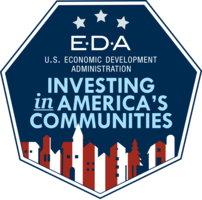
EDA American Rescue Plan Funding Programs
The Economic Development Administration (EDA) American Rescue Plan Funding Programs offers $3 billion in funding opportunities to invest in distressed and underserved communities impacted by the coronavirus pandemic. This historic investment will support bottom-up, middle-out economic development focused on advancing equity, creating good-paying jobs, helping workers to develop in-demand skills, building economic resilience, and accelerating the economic recovery for the industries and communities hit hardest by the coronavirus pandemic. Click on the links for EDA American Rescue Plan Programs Overview and Resources.
See Various Application Deadlines Listed Below:
|
USDA Seeks Applications to Support Regional Economic and Community
Development Planning to Help Rural People
The US Department of Agriculture (USDA) is seeking applications to implement projects supported by regional economic and community development planning to help the people of rural America build back better. The 2018 Farm Bill authorized USDA to make this funding available under the Strategic Economic and Community Development (SECD) initiative. It can be used to implement projects that are supported by multi-jurisdictional and multi-sectoral strategic community investment plans. In fiscal year 2022, this funding is available under the following USDA Rural Development programs:
To be eligible for SECD reserved funding, applicants must meet the requirements and deadlines under the
covered programs. Applicants must also submit a Form 1980-88 to USDA. See additional requirements below.
For more information on requirements and deadlines under the covered programs, visit www.rd.usda.gov. For additional information on SECD funding, see page 57409 of the Oct. 15, 2021, Federal Register.
The National Fish and Wildlife Foundation (NFWF), in coordination with the National Oceanic and Atmospheric Administration (NOAA), announces the 2021 Emergency Coastal Resilience Fund (ECRF) to support projects that increase the resilience of coastal communities impacted by hurricanes and wildfires in 2020 and 2021. The fund supports conservation projects that create and restore natural systems to help protect coastal communities from the impacts of coastal storms, floods, sea-level rise, inundation, coastal erosion, wildfires and associated landslides/debris flows, and enable communities to recover more quickly from these events, all while improving habitats for fish and wildlife species. The ECRF seeks to fund shovel-ready projects to improve wildlife habitat that also improves community resilience and recovery both in and around impacted areas. Proposals are due Feb. 3, 2022. Learn more and apply here.
USDA is accepting applications for the FFWR grant program, which will provide $665 million to fund competitive grant applications to provide relief to farmworkers and meatpacking workers who incurred pandemic-related health and safety costs. Of the $665 million, $20 million is set aside for at least one pilot program to support grocery workers in recognition of their essential role. The new program is funded by the Consolidated Appropriations Act of 2021 and is part of USDA’s Build Back Better efforts to respond and recover from the pandemic. Application Deadline: Mar. 10, 2022.
USDA Rural Development offers grants to qualified nonprofits and public housing authorities to provide technical assistance to qualified borrowers and applicants to facilitate the acquisition of properties. Application Deadline: Feb. 8, 2022
The National Endowment for the Arts (NEA) Grants for Arts Projects is offering up to $100,000 for arts and culture projects that enhance communities through the humanities, complement revitalization, and better connect cross-sector stakeholders. The program supports public engagement with, and access to, various forms of art across the nation, the creation of excellent art, learning in the arts at all stages of life, and the integration of the arts into the fabric of community life. Projects should focus on creativity and/or cultural heritage, livability, learning, and engagement.
A project may consist of one or more specific events or activities. Organizations may apply for any or all phases of a project, from its planning through its implementation. In recognition of the United States of America’s 250th anniversary in 2026, arts projects that educate and engage communities in dialogue about the past, present, and future of the nation are welcome to apply. Application Deadline: Feb. 10, 2022.
Latino and immigrant communities continue to be affected by the existing challenges of neighborhood change and involuntary displacement, challenges that have only been compounded by the economic effects of the COVID-19 pandemic, so it makes equitable neighborhood development more relevant than ever. NALCAB will provide two cohorts of grants to support the implementation of an existing development action plan (Implementation Grants). NALCAB anticipates awarding up to 12 grants for a period of 12 months. The application deadline is Feb. 14 at 11:59 p.m. PT and the grant period is Apr. 1, 2022 - Mar. 31, 2023.
FEMA released the funding notice for $46 million available through the Fiscal Year 2021 Fire Prevention and Safety (FP&S) grants. These grants are part of the Assistance to Firefighters Grants Program and focus on reducing injury and preventing death among high-risk populations.
The FP&S Program provides financial assistance directly to eligible fire departments, national, regional, state, local, tribal and non-profit organizations such as academic (e.g., universities), public health, occupational health, and injury prevention institutions for fire prevention programs. The program also supports firefighter health and safety research and development such as clinical studies that address behavioral, social science, and cultural research. Examples of research and development grants and descriptions of completed projects that have been funded under this program can be found on FEMA’s website.
FEMA will host a series of webinars to provide an overview of the FY 2021 FP&S Program and assist with navigating the grant application. The upcoming webinar schedule is as follows:
- FY 2021 FP&S Activity - Tuesday, Feb. 1, 1 - 2:30 p.m. EST.
- FY 2021 FP&S Activity - Wednesday, Feb. 9, 3 – 4:30 p.m. EST.
Advanced registration is not required for these webinars. Webinar sessions will be broadcast using an Adobe Connect webinar link. FEMA suggests saving this link to your web browser's favorites:
A conference line will also be available at 800-320-4330, Conference Code: 258436.
The funding notice and application assistance documents for this grant program are available at grants.gov and FEMA.gov. For questions, contact FEMA's Fire Grants HelpDesk via email at firegrants@fema.dhs.gov. Application Deadline: Feb. 18, 2022.
This funding opportunity is offering up to $750,000 to fund sub-grant programs that foster the economic development of rural communities through the rehabilitation of historic properties. This program will fund architecture/engineering services and physical preservation of historic sites listed in or determined eligible for listing in the National Register of Historic Places. Application Deadline: Feb. 22, 2022
USDA Rural Development's Rural Utilities Service issued a Funding Opportunity Announcement (FOA) announcing that it will begin accepting applications for FY2022 for the Rural eConnectivity Program (or ReConnect Program). The application window will open on Nov. 24, 2021.
The USDA Rural Development Rural Utilities Service (RUS) will be conducting a three-day workshop for those interested in applying for ReConnect Program funding. The workshop will take place virtually and provide attendess with an understanding of the ReConnect Program application system and program requirements for FY2022. Topics include: Program Eligibility; Evaluation Criteria; Live Demonstrations of the Application System; Overview and deep dive sessions on financial, network, environmental, and mapping requirements; and Compliance and Post-award Reporting.
Both workshops will present the same content. Workshop content will be posted on the ReConnect website as soon as possible after the workshops are completed. Application deadline: Feb. 22, 2022
Pursuant to the American Rescue Plan Act of 2021 (ARP), EPA announces the availability of funds and solicits applications from eligible entities to conduct ambient air monitoring of pollutants of greatest concern in communities with environmental and health outcome disparities stemming from pollution and the COVID-19 pandemic. EPA will award funds to support community and local efforts to monitor their own air quality and to promote air quality monitoring partnerships between communities and tribal, state, and local governments. The total estimated funding for this competitive opportunity is approximately $20,000,000. Approximately $2 million dollars of this amount will be awarded to tribal governments under a tribal government set-aside, and approximately $2 million will be awarded to eligible community-based organizations under a community-based organization set-aside. Overall, EPA anticipates awarding a total of approximately 50-70 assistance agreements (cooperative agreements or grants) from this announcement, subject to availability of funds, the quality of applications received, agency priorities, and other applicable considerations. EPA anticipates awarding approximately 20-30 assistance agreements ranging in value from $25,000 to $100,000 (i.e., “Small Grants”) and 30-40 assistance agreements ranging in value from $100,001-$500,000 (i.e., “Large Grants”). EPA may increase or decrease the total funding or set-aside amounts based on the number of meritorious applications received, agency priorities, funding availability, and other applicable considerations. View more information about this grant opportunity at this link. Application Deadline: Mar. 25, 2022.
USDA Rural Development is accepting applications to support economic development and create jobs for people in rural America. This program is designed to provide technical assistance and training for small rural businesses. Small means that the business has fewer than 50 new workers and less than $1 million in gross revenue. Application Deadline: Feb. 28, 2022
The National Telecommunications and Information Administration (NTIA) will host broadband grant program public virtual listening sessions in connection with the five new broadband grant programs authorized and funded by the Infrastructure Investment and Jobs Act: The Broadband Equity, Access, and Deployment Program; the Enabling Middle Mile Broadband Infrastructure Program; and the Digital Equity Act Programs, which include the State Digital Equity Planning Grant Program, State Digital Equity Capacity Grant Program, and Digital Equity Competitive Grant Program. These public virtual listening sessions are designed to collect stakeholder input to help inform program development and implementation. NTIA will hold the public virtual listening sessions based on the following schedule:
- Infrastructure Investment and Jobs Act Broadband Programs Public Virtual Listening Session #4: Wednesday, Feb. 9, 2022, from 2:30–4 p.m.
- Infrastructure Investment and Jobs Act Broadband Programs Public Virtual Listening Session #5: Wednesday, Feb. 23, 2022, from 2:30–4 p.m.
These listening sessions will be hosted via NTIA’s virtual platform and conducted as a live public listening session. NTIA will post the registration information on its BroadbandUSA website at https:// broadbandusa.ntia.doc.gov/events/latest-events. For further information contact Maci Morin, National Telecommunications and Information Administration, US Department of Commerce, Room 4872, 1401 Constitution Avenue NW, Washington, DC 20230; telephone: (202) 482–4884; email: BroadbandForAll@ntia.gov.
T-Mobile partnered with Smart Growth America and Main Street America, two consulting partners with a combined experience of over 60 years working to help build stronger, more prosperous small towns and rural communities. With our Hometown Grant program, we’re investing big in small towns by awarding up to 100 towns a year with project funding—up to $50,000 each. Applications will be open on a quarterly basis with the following schedule:
- Spring: Applications open January – March
- Summer: Applications open April – June
- Fall: Applications open July – September
- Winter: Applications open October – December
The U.S. Department of the Interior’s (Department) WaterSMART (Sustain and Manage America’s Resources for Tomorrow) Program provides a framework for Federal leadership and assistance to stretch and secure water supplies for future generations in support of the Department’s priorities. Through WaterSMART, the Bureau of Reclamation (Reclamation) leverages Federal and non-Federal funding to support stakeholder efforts to stretch scarce water supplies and avoid conflicts over water. Application Deadline: Mar. 15, 2022.
The AARP Community Challenge provides small grants to fund quick-action projects that can help communities become more livable for people of all ages. This year, applications will be accepted for projects to improve public spaces; housing; transportation; civic engagement; diversity, equity and inclusion; support efforts to build engagement for programs under new federal laws; and other innovative ideas that support people age 50 or older. Questions about the AARP Community Challenge can be directed to CommunityChallenge@aarp.org. Application Deadline: Mar. 22, 2022.
USDA Rural Development (RD) program which provides loans and grants to Microenterprise Development Organizations to help microenterprises startup/grow through a Rural Microloan Revolving Fund and provide training and technical assistance to microloan borrowers and micro entrepreneurs. RMAP FY22 Funding Announcement. Application Deadline: To the RD State Office no later than 4:30 p.m. (local time): Mar. 31, 2022 and June 30, 2022.
US Department of Agriculture - Rural Development (USDA-RD) provides zero-interest loans and grants to Rural Utilities Service’s Electric and Telecom Program borrowers to use the funds to help local businesses finance projects that will create and retain jobs. Application Deadlines: Mar. 31, 2022; and June 30, 2022, to the USDA Rural Development State Office.
The US Department of Agriculture is accepting applications for loan guarantees and grants for renewable energy systems; and to make energy efficiency improvements, conduct energy audits and provide development assistance. Funds are being made available under the Rural Energy for America Program (REAP). USDA is seeking applications for Fiscal Year 2022 funding.
Agricultural producers and rural small businesses are eligible applicants for loan guarantees and grants for renewable energy systems and to make energy efficiency improvements. State and local governments, federally recognized tribes, land-grant colleges or universities or other institutions of higher education, rural electric cooperatives, public power entities, and Resource Conservation & Development Councils (as defined in 16 USC §3451) are eligible applicants for grants to conduct energy audits and provide development assistance.
The deadline to apply for grants is Mar. 31, 2022. Applications for loan guarantees are accepted year-round.
Interested applicants are encouraged to contact their local USDA Rural Development State Energy Coordinator well in advance of the application deadlines to discuss their project and ask any questions about the REAP program or the application process.
Additional information on the required materials and how to apply for the REAP program are available on page 40000 of the July 26, 2021, Federal Register.
The US Department of Transportation (DOT) Rebuilding American Infrastructure with Sustainability and Equity (RAISE) grant program, formerly known as the BUILD or TIGER programs, is offering up to $25 million to support highways, bridges, road projects, public transportation projects, passenger and freight rail transportation projects, port infrastructure, and intermodal projects that promise to achieve national objectives. The FY22 RAISE grants will be awarded to surface transportation infrastructure projects that will have a significant local and regional impact.
For this round of RAISE funding, implementation grants may not be less than $5 million or greater than $25 million, except for projects located in rural areas where the minimum award size will be $1 million. A 20 percent match is required. Eligible applicants include State, local, and tribal governments including transit agencies, port authorities, metropolitan planning organizations, and other political subdivisions of state or local governments. States and jurisdictions may also submit joint applications. Application Deadline: Apr. 14, 2022.
USDA Rural Development invests in rural transportation, through the Rural Business Development Grant, to build opportunity for prosperity for organizations seeking to improve passenger services and facilities. Federal Register. Application Deadline: Apr. 14, 2022.
USDA is accepting grant applications that will advance equity in rural America by creating new opportunities in distressed communities. The RISE grant program encourages a regional, innovation-driven approach to economic development by funding job accelerator partnerships in low-income rural communities. This includes communities that have been historically underserved, marginalized and adversely affected by persistent poverty and inequality.
RISE provides grants of up to $2 million to consortiums of local governments, investors, industry, institutions of higher education, and other public and private entities in rural areas. The funding may be used to support innovation centers and job accelerator programs that improve the ability of distressed rural communities to create high-wage jobs, form new businesses, and identify and maximize local assets. USDA encourages applications that serve the smallest communities with the lowest incomes. USDA is offering priority points to projects that advance key priorities under the Biden-Harris Administration to help communities recover from the COVID-19 pandemic, advance equity and combat climate change. These extra points will increase the likelihood of funding for projects seeking to address these critical challenges in rural America. Potential applicants may submit a concept proposal for review by the agency to SM.USDA-RD.RISE@usda.gov. Applicants are also encouraged to contact their nearest USDA Rural Develoment State Office ahead of the application deadline for more information about the program or the application process. Applications must be submitted through Grants.gov. Application Deadline: Apr. 19, 2022, 11:59 p.m. EST.
USDA Rural Development offers this new program to support underserved communities deploy community-scale renewable energy technologies and innovations to reduce climate pollution and increase resilience to the impacts of climate change. Federal Register. Letter of Intent Required by Apr. 19, 2022.
The National Endowment for the Arts (NEA) Challenge America Grant Program is offering up to $10,000 to support projects that extend the reach of arts to underserved populations, including those whose opportunities to experience the arts are limited by geography, ethnicity, economics, or disability. Applicants are encouraged to consider partnerships among organizations, both in and outside the arts, as appropriate to their project. Challenge America supports arts projects in all artistic disciplines. Eligible applicants include small and midsized organizations such as nonprofits, units of state or local government, and federally recognized tribal communities or tribes that have not received funding from the NEA in the past three fiscal years. Applicants may be an arts organization, local arts agency, arts service organization, local education agency or school district, or other organization that can help advance NEA goals. All organizations must have a three-year history of programming prior to the application deadline. Application Deadline: Apr. 21, 2022.
The Delaware Valley Regional Planning Commission (DVRPC) is soliciting applications for the Transportation & Community Development Initiative (TCDI). TCDI supports smart growth initiatives that implement the region’s long-range plan, Connections 2050, and enhance the multimodal transportation network. The program is available to municipal and county governments, transit agencies, and Transportation Management Associations (TMAs) located in DVRPC’s five Pennsylvania counties. Up to $1.2 million may be available in this round. Local match is no longer required. Detailed program guidelines will be available on Feb. 1, 2022.
Interested applicants should attend an informational webinar on Mon., Feb. 14, 2022, at 9:30 a.m. Registration for this webinar is required. All questions regarding the application and guidelines must be addressed via email to sgober@dvrpc.org. Application Deadline: Apr. 27, 2022.
USDA-National Institute of Food and Agriculture’s Rural Health and Safety Education Competitive Grants (RHSE) program supports quality of life in rural communities across the United States by addressing the needs of rural Americans’ individual and family health and safety in the context of food, agriculture, natural resources, and human sciences. RHSE fosters, improves, and coordinates education programs among Federal agencies, other levels of government, and institutions and private organizations in rural areas, to disseminate information about rural health and safety.
RHSE program proposals are expected to be community-based, outreach education programs, such as those conducted through Human Science extension outreach, that provides individuals and families with: Information as to the value of good health at any age; Information to increase individual or family’s motivation to take more responsibility for their own health; Information regarding rural environmental health issues that directly impact on human health; Information about and access to health promotion and educational activities; and training for volunteers and health services providers concerning health promotion and health care services for individuals and families in cooperation with state, local and community partners.
USDA will be conducting a Request for Applications Webinar on Feb. 23, 2022 from 2-3 p.m. Registration is not required. The zoom meeting link for this webinar is: https://www.zoomgov.com/j/1616471930.
For more information, read the RHSE funding opportunity announcement. Application deadline: Apr. 29, 2022.
The U.S. Department of Agriculture (USDA) today announced the availability of $72.9 million through the Specialty Crop Block Grant Program (SCBGP) to fund innovative projects designed to support the expanding specialty crop sector and explore new market opportunities for U.S. food and agricultural products.
The SCBGP funds are allocated to U.S. states and territories based on a formula that considers both specialty crop acreage and production value. Interested applicants should apply directly through their state departments of agriculture. USDA’s Agricultural Marketing Service (AMS) manages this grant program and a listing of state contacts is available on its website. AMS encourages applications that serve smaller farms and ranches, new and beginning farmers and ranchers, socially disadvantaged producers, veteran producers, and/or underserved communities. For grants intending to serve these audiences, applicants should engage and involve those beneficiaries when developing projects and applications.
Applications from the states and territories must be submitted electronically through www.grants.gov by 11:59 p.m. Eastern Time on May 3, 2022. Any grant application submitted after the due date will not be considered unless the applicant provides documentation of an extenuating circumstance that prevented their timely submission of the grant application. Read more in AMS Late and Non-Responsive Application Policy. For more information about grant eligibility, visit the SCBGP website or contact the SCBGP Team at scbgrants@usda.gov.
USDA Rural Development’s Community Facilities Emergency Rural Health Care Grants are designed to help broaden access to COVID-19 testing and vaccines, rural health care services, and food assistance through food banks and food distribution facilities. Recovery Grants provide immediate relief to address the economic conditions arising from the COVID-19 emergency. Application Deadline: Until all funds are exhausted
The Workforce Opportunity for Rural Communities (WORC) Initiative offers grants for projects in the Appalachian region and Lower Mississippi Delta region that will provide career training and support services to eligible individuals in counties and parishes and/or areas currently underserved by other resources. Grants will support workforce development activities that prepare dislocated workers, new entrants to the workforce, and incumbent workers for good jobs in high-demand occupations aligned with a regional or community economic development strategy. Application Deadline: July 21, 2022.
Community Response Projects are supported for up to $5,000 over a 6-month time frame and will be awarded to community-based organizations that provide supports to people with developmental disabilities who have been affected by a local, statewide, or national, natural disasters. This can include, but is not limited to, addressing concerns related to the Covid-19 pandemic. Community Response Project funding should be used to develop training or increase accessibility to information for individuals with developmental disabilities and their family members. This funding opportunity is year round/ongoing/rolling.
USDA Rural Development helps private lenders provide affordable financing to qualified borrowers to improve access to clean, reliable water and waste disposal systems in rural areas. Application Deadline: Ongoing
USDA Rural Development loans and loan guarantees for the construction, maintenance, improvement, and expansion of telephone service and broadband in rural areas. Application Deadline: Ongoing
The Affordable Connectivity Program is an FCC benefit program that helps ensure that households can afford the broadband they need for work, school, healthcare and more. The benefit provides a discount of up to $30 per month toward internet service for eligible households and up to $75 per month for households on qualifying Tribal lands. Eligible households can also receive a one-time discount of up to $100 to purchase a laptop, desktop computer, or tablet from participating providers if they contribute more than $10 and less than $50 toward the purchase price. The Affordable Connectivity Program is limited to one monthly service discount and one device discount per household.
Recipients fully enrolled as of Dec. 31, 2021 will automatically continue to receive their current monthly benefit until Mar. 1, 2022. Learn more the program transition and steps needed to take to stay enrolled after Mar. 1st, by visiting fcc.gov/broadbandbenefit. The Consumer Outreach Toolkit includes Affordable Connectivity Program social media images, fact sheets, and other outreach content and materials that can be customized for consumer awareness campaigns.
The electric program makes insured loans and loan guarantees to nonprofit and cooperative associations, public bodies, and other utilities. Insured loans primarily finance the construction of electric distribution facilities in rural areas. The guaranteed loan program has been expanded and is now available to finance generation, transmission, and distribution facilities. The loans and loan guarantees finance the construction of electric distribution, transmission, and generation facilities, including system improvements and replacement required to furnish and improve electric service in rural areas, as well as demand side management, energy conservation programs, and on-grid and off-grid renewable energy systems. Application Deadline: Ongoing
Who may apply? Most retail or power supply providers serving qualified rural areas, including:
- State and local governmental entities
- Federally recognized tribes
- Nonprofits including cooperatives and limited dividend or mutual associations
- For-profit businesses (must be a corporation or limited liability company)
This program helps very small, financially distressed rural communities with predevelopment feasibility studies, design and technical assistance on proposed water and waste disposal projects. Application Deadline: Ongoing
Who may apply?
- Most state and local governmental entities
- Nonprofits
- Federally recognized tribes
The Emergency Collections Assessment for Preservation (CAP) program, an FAIC program supported under a cooperative agreement with the Institute of Museum and Library Services, aims to support museums impacted by disasters. The goal of a CAP is to improve the care of collections for museums with limited resources. Two assessors, a collections care/conservation specialist and a building specialist, are selected by the affected museums. The assessors will provide specific guidance on prioritizing what actions will have the greatest impact for collections care. The Emergency CAP focuses on providing recommendations for assessing risk, improving impacted facilities, and other recovery strategies to help care for collections affected by an emergency incident.
Applications are accepted on a rolling basis and the assessments are completed on a timeline established by the requesting museum. Over a two-day site visit, the two assessors will evaluate what are the most immediate collections threats and later provide a report to the institution with their recommendations for moving forward. Institutions should apply as soon as they are able.
This program is available for US/Tribal/Territory museums of any size with at least one full time staff member or volunteer(s) totaling 40 hours per week. Collections must be made available to the public through exhibitions or research regularly. Larger institutions will receive a more narrowly focused report due to the amount of information that can be gathered during a two-day site visit. Museums interested in applying for an Emergency CAP should contact program staff at cap@culturalheritage.org or 202.750.3346.
The National Science Foundation (NSF) Smart and Connected Communities (S&CC) Program is offering up to $2.5 million to provide tools and resources that integrate technology into all levels of society. The S&CC program is intended to bring increased levels of economic opportunity & growth, safety & security, health & wellness, accessibility & inclusivity, and overall quality of life to communities.
Competitive applicants should work alongside community stakeholders to identify and define challenges they are facing to establish research priorities. NSF highly encourages research that addresses fundamental technological and social science dimensions of smart and connected communities and considers the sustainability of the research outcomes beyond the life of the project.
All interested in conducting science & technology research and development are welcome to apply. No match is required. Applications for the Smart and Connected Communities program are rolling and will be awarded on a first-come basis.
USDA Rural Development partners with lenders to guarantee loans to help eligible entities expand meat and poultry processing capacity and finance other food supply chain infrastructure. Fact Sheet. Federal Register. Application Deadline: Until funds are exhausted
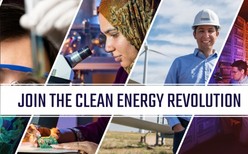
As the largest funder of clean energy technology in the country, DOE has led the way on the innovations that have brought us the wind, solar, and energy efficient technology we know today. Now, with the investments from the Bipartisan Infrastructure Law, DOE’s Clean Energy Corps will be able to do even more. With a focus on deploying next generation clean energy technology, the Clean Energy Corps will help America meet its goals of a carbon-free power sector in 2035 and a decarbonized economy in 2050. But we can’t do it without YOU.
The Clean Energy Corps is hiring NOW. With the passage of the Bipartisan Infrastructure Law, the Clean Energy Corps is charged with investing more than $62 billion to deliver a more equitable clean energy future for the American people. The Clean Energy Corps is looking for new team members from every community in America who are passionate about solving the climate crisis, are team players, and are willing to give their all to this fight.
DOE is collecting resumes for candidates interested in becoming part of the Clean Energy Corps via its Applicant Portal. The Applicant Portal is a streamlined application process which will allow applicants to align their talents with their passion by indicating specific areas of interest and allow hiring managers throughout the agency to review candidate resumes simultaneously to find the best fit in DOE.
|
|
TOOLS, TRAININGS, AND RESOURCE UPDATES
Webinars
County Broadband Program Implementation: Key Considerations. Feb. 1, 2022, 12-1 p.m.
CDFA-Bricker Webinar Series: Financing Green and Sustainable Assets - Green Financing 101. Feb. 1, 2022, 2-4 p.m.
Survey Findings on Mayors and Homelessness: Challenges, Opportunities, and Solutions. Feb. 2, 2022, 1-2:15 p.m.
Community Resilience Hubs: A Model for Advancing Climate Resilience in Baltimore. Feb. 2, 2022, 4-5 p.m.
From Complete Streets to Complete Networks: A Data-driven, Performance-based, Multimodal Planning Tool. Feb. 3, 2022, 1-2 p.m.
Showcasing Leading Practices in Climate Adaptation: Experiences from the Water Sector to Empower Other Sectors and Communities Webinar Series.
-
Climate Warming and Impacts to Staff and Assets. Feb. 3, 2022, 1-3 p.m.
-
Federal and Other Funding for Adaptation. Feb. 17, 2022, 1-2 p.m.
Incorporating Regionalism in Economic Development. Feb. 3, 2022, 2:30-3:15 p.m.
National League of Cities ARPA Office Hour: Storytelling + Advocacy. Feb. 9, 2022, 1-2 p.m.
Bridging the Equity Gap: Flood Resilience for the Whole Community Webinar Series - No Resilience Without Representation. Feb. 9, 2022, 3-4:15 p.m.
Small Business's Big Moment. Feb. 10, 2022, 2-3 p.m.
Economic Development in a Changing Climate. Feb. 10, 2022, 2-3 p.m.
2-Part Workshop: Managing Philadelphia's Flood Risk in a Changing Climate
Advancing Racial Justice and Equity in Public Policy. Feb. 11, 2022, 12-1 p.m.
How to Write Your First Grant. Feb. 17, 2022, 11 a.m.-12 p.m.
Reinventing Capital Products for Equitable Economic Development. Feb. 17, 2022, 11 a.m.-12 p.m.
Mid-Atlantic Planning Collaboration: Planning for Clean Water Webinar Series
-
Plan Integration for Resilience and Equity. Feb. 17, 2022, 12-1 p.m.
-
Leveraging Hazard Mitigation for Water Quality Benefits. Mar. 17, 2022, 12-1 p.m.
-
How to Leverage Conservation, Open Space, and Parks Funding to Maximize Multiple Benefits. Apr. 21, 2022, 12-1 p.m.
-
The One Water Approach and How It Benefits the Bay. May 19, 2022, 12-1 p.m.
-
Smart Growth Tools for Protecting Water Resources. June 16, 2022, 12-1 p.m.
FEMA and Philanthropy: How to Best Utilize Your Dollars and Avoid Duplication. Feb. 17, 2022, 2-3 p.m.
Future-focused Economic Development in Rural America. Feb. 17, 2022, 2-3:30 p.m.
Investing ARPA Funds in Behavioral Health Crisis Response. Feb. 22, 2022, 3-4 p.m.
Aspen Tech Policy Hub Demo Day: Equipping Vulnerable Communities for 21st Century Needs. Mar. 15, 2022, 12-1 p.m.
Introducing the International Economic Development Council (IEDC) Pandemic Resilience and Recovery Resources. June 2, 2022, 2:30-3:15 p.m.
Tale from the Trenches: Hurroicane Recovery. Aug. 25, 2022, 2:30-3:15 p.m.
ARPA: What Have We Learned? Dec. 15, 2022, 2:30-3:15 p.m.
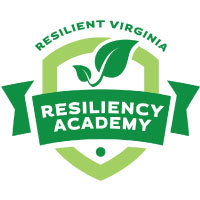
SAVE THE DATE: Resilient Virginia Spring 2022 Resiliency Academy
The Resiliency Academy Spring 2022 series will feature four webinars highlighting the components of a Resilient Community that are championed by Resilient Virginia. Registration for these events will open in Feb. 2022.
-
Economic Activities: Innovative Financing. Mar.10, 2022, 1–2:30 p.m.
-
Community Action: Tools for Resiliency Planning. Apr. 7, 2022, 1–2:30 p.m.
-
Ecosystem Services: Green Infrastructure Utilized. May 12, 2022, 1–2:30 p.m.
-
Infrastructure and Buildings: Progress Report. June 9, 2022, 1–2:30 p.m.
|
Trainings
CONVERGE Training Modules (Now available: Social Vulnerability and Disasters; Disaster Mental Health)
Basically Community Development Block Grant (CDBG) Online Curriculum (provides a suite of information and tools to help CDBG grantees understand basic CDBG requirements and drill down into more nuanced issues related to the administration and implementation of the program)
FEMA Mitigation Training Webinar: Incorporating Future Conditions in Mitigation Plans
SAVE THE DATE! HUD CDBG-DR Problem Solving Clinic. Mar. 29-31, 2022; Virtual delivery. More details available soon.
National Center for Disaster Preparedness: FEMA Housing Recovery (web-based training)
- Addressing Gaps In Housing Disaster Recovery: Conducting Impact Assessments
- Addressing Gaps In Housing Disaster Recovery: Pre-Disaster Planning
- Addressing Gaps In Housing Disaster Recovery: Post-Disaster Planning
National Disaster Preparedness Training Center at the University of Hawai'i
- AWR-356: Community Planning for Disaster Recovery (Virtual Deliveries: Apr. 19, July 21, Oct. 4, Oct. 20)
- AWR-228: Community Resilience (Virtual Deliveries: Mar. 15, Mar. 29)
- AWR-377: Disaster Resilience Workshop for Small Businesses (Virtual Deliveries: Mar. 4, June 16, July 13, Dec. 12)
The Frederick Community College Mid-Atlantic Center for Emergency Management and Public Safety (MACEM&PS) is offering a new online training program fro emergency managers and other community leaders nationwide focues on logistical supply chain components during an emergency. The Community Lifelines, Logistics, and Supply Chain Awareness courses will teach participants how to apply supply chain strategies to community-based emergency planning and prepare for the rapid recovery and continuation of required essential services and critical resources. The MACEM&PS developed the training through a Continuing Training Grant from FEMA’s National Training and Education Division. For more information,or email CommunityLifelines@frederick.edu.
|
Resources
US Department of Agriculture Disaster Assistance Programs At A Glance
Jump-starting the Green New Deal
Financing Our Green Future
National Association of Counties (NACo) Analysis: Overview of US Treasury's Final Rule for ARPA Fiscal Recovery Fund
Resources for Planning and Implementing Green Infrastructure and Nature-based Solutions
Environmental Protection Agency (EPA): Emergencies and Indoor Air Quality
Environmental and Energy Study Institute (EESI): Federal Resilience Programs Article Series
Partnership for Healthy Cities Resource Library
Community Guide to Federal Broadband Opportunities
Measuring the State of Disaster Philanthropy Interactive Map and Report
Guides
How Cities Can Redefine Progress Toward Equity for Well-Being
Reimagining Public Space to Support Main Street Retail: Municipal Action Guide
The Future of Cities: A Roadmap to Inclusive Entrepreneurship: Municipal Action Guide
National Governors Association (NGA) State Governance, Planning, and Financing to Enhance Energy Resilience
The Beginner's Guide to Effective Online Engagement
Adaptation for All: How to Build Flood Resilience for Communities of Every Size
Guidance
US Treasury Final Rule for the State and Local Coronovirus Fiscal Recovery Fund
Reports
How States Can Best Use Federal Fiscal Recovery Funds: Lessons From State Choices So Far
A New Era of Racial Equity in Community Development Finance: Leveraging Private and Philanthropic Commitments in the Post-George Floyd Period
Addressing the Impact of COVID-19 on the Ealrly Care and Education Sector
Social Isolation and Loneliness in Older Adults: Opportunities for the Health Care System
American Planning Association Community Planning Assistance Team Report: Recovery Planning Concepts: LaPlaya de Ponce, Puerto Rico
2021 National Healthcare Quality and Disparities Report
The Economic Value of America's Estuaries: 2021 Report
Nonprofit Trends and Impacts 2021: National Findings on Diversity and Representation, Donation Trends from 2015-2020, and Effects of 2020
Videos
Alliances for Climate Action Virtual Forum, October 2021
Bootstrapping Federal Grants on Your Way to Green Resilience
|
Recorded Webinars
Bridging the Equity Gap: Flood Resilience for the Whole Community Webinar Series
Smart Growth Online Webinar Archives
Penn Institute of Urban Research/Volcker Alliance
NACo's Information Series on Treasury's Final Rule for the ARPA Fiscal Recovery Fund
The Role of Social Systems in Preparing, Responding, and Recovering from Catastrophic Events
Green and Nature-based Infrastructure Solutions for New England
Council fo Development Finance Agencies (CDFA) Infrastructure Finance Series
CDC Climate and Health Webinar Archive
Equity and Environmental Justice in Climate Solutions Webinar Series
Tools/Toolkits
US Department of Agriculture Disaster Assistance Discovery Tool
National League of Cities Local Fiscal Recovery Funds Playbook
Reimagining Public Safety: A Toolkit for Cities and Towns
National League of Cities: Digital Equity Playbook: How Cities Leaders Can Bridge the Digital Divide
Understanding Your Local Eviction Landscape: A Worksheet for City Officials
NACo Toolkit: Tracking COVID-19 Relief for Human Services and Education Programs
Sustainable Working Waterfronts Toolkit
Disaster Preparedness to Promote Community Resilience: Information and Tools for Homeless Service Providers and Disaster Professionals
Podcasts
Resilient Nation Partnership Network (RNPN) "Building Alliances for Equitable Resilience" Audio Stories
Good Government Show
Metropolitan Washington Council of Governments (MWCOG) Think Regionally Podcast
|
Conferences
2022 Delaware Wetlands Conference. Feb. 1-2, 2022; Wilmington, DE.
2022 Social Coast Forum. Feb. 1-3, 2022; Charleston, SC.
Consortium for Scenario Planning 2022 Conference. Feb. 3-4, 2022; Virtual.
National Conference of Regions. Feb. 6-8, 2022; Washington, DC.
2022 Safe Streets Summit: Resilient and Adaptive Streets. Feb. 17-18, 2022; Miami, FL.
National League of Cities Congressional City Conference. Mar. 14-16, 2022; Washington, DC.
Appalachian Regional Commission Outdoor Economy Conference. Apr. 4-7, 2022; Cherokee, NC.
2022 National Outdoor Recreation Conference. May 2-5, 2022; Knoxville, TN.
Aspen Ideas: Climate. May 9-12, 2022; Miami Beach, FL.
2022 Association of State Floodplain Managers (ASFPM) Conference. May 15-19, 2022; Orlando, FL.
Association of Metropolitan Planning Organizations (AMPO) 2022 Planning Tools and Training Symposium. May 16-19, 2022; Fort Lauderdale, FL.
2022 Natural Hazards Research and Applications Workshop - Changing Climates: Equity and Adaptation in a Warming World. July 10-13, 2022; Broomfield, CO.
|
Conferences (cont.)
2022 National Working Waterfront Network Conference. July 19-21, 2022; Boston, MA.
National Adaptation Forum. Oct. 25-27, 2022; Baltimore, MD.
Articles of Interest
A Small City’s Hurricane Recovery Could Help Other Communities Bounce Back
Maryland Town Turns Flood Zone Into A Tourist Attraction
Housing Investments Made During the Pandemic Are Effective, But More is Needed
Using Data-driven Insights to Help Revive a Historic New Orleans Neighborhood
Expert Voices 2022: Reimagining Infrastructure
Setting a Path to Green, Resilient, and Inclusive Development (GRID)
How Partnerships Can Lead to Emergency Rental Assistance Program Success
Countering Rural Disinvestment: Appalachia’s Ecosystem-Based Approach
Retail Revival: Tough, But Not Impossible
The Pandemic Exscerbated the Child Care Crisis. How Can States Reverse the Trend?
10 Steps for Advancing Equity With American Rescue Plan Funding
|
|
|